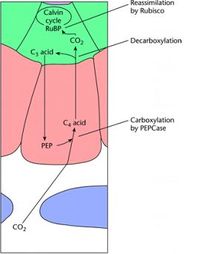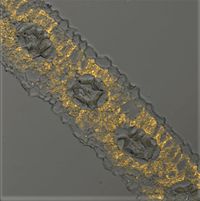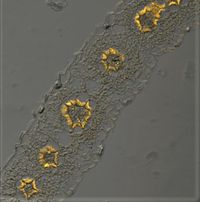C4 Carbon Fixation: Difference between revisions
m The LinkTitles extension automatically added links to existing pages (<a rel="nofollow" class="external free" href="https://github.com/bovender/LinkTitles">https://github.com/bovender/LinkTitles</a>). |
|||
| Line 16: | Line 16: | ||
*Sorghum | *Sorghum | ||
In many subtropical, tropical, and desert climates, C4 plants are the primary economic agricultural generators due to their carbon fixation efficiency and ability to retain water. "Drought is a major agricultural problem worldwide. Therefore, selection for increased water use efficiency (WUE) in food and biofuel crop species will be an important trait in plant breeding programs" [3]. With [[climate change]] in mind, C4 plants are becoming much more favorable in agriculture as they are resilient in the face of warmer ambient temperatures and drier seasons. | In many subtropical, tropical, and desert climates, C4 plants are the primary economic agricultural generators due to their carbon fixation efficiency and ability to retain water. "Drought is a major agricultural problem worldwide. Therefore, selection for increased water use efficiency (WUE) in food and biofuel crop species will be an important trait in plant breeding programs" [3]. With [[climate change]] in mind, C4 plants are becoming much more favorable in [[agriculture]] as they are resilient in the face of warmer ambient temperatures and drier seasons. | ||
==Evolution== | ==Evolution== | ||
Latest revision as of 13:04, 10 May 2023
Description

The Hatch-Slack pathway, also known as the C4 plant carbon fixation pathway, involves the storing of atmospheric CO2 in bundle sheath cells. "The evolution of C4 photosynthesis ~35–40 million years ago provided a natural solution to remedy the inefficiency of Rubisco" [2]. The Hatch-Slack pathway is acknowledged for its improved efficiency, where the concentration of CO2 is increased around the enzyme Rubisco in order to reduce photorespiration.
Anatomy and Function


C4 plants exhibit a Kranz-type leaf anatomy involving two photosynthetic cells known as mesophyll cells and bundle sheath cells which differ in their CO2 assimilation functions [1]. In mesophyll cells, atmospheric carbon dioxide is converted to a C4 acid by the enzyme phosphoenolpyruvate carboxylase (PEP Case) during the carboxylation phase of carbon fixation. In this step, PEP Case catalyzes the reaction between bicarbonate, HCO3-, and phosphoenolpyruvate (PEP), a three-carbon molecule, to form the four-carbon acid oxaloacetate and inorganic phosphate [4]. The four-carbon acids are then transported to the bundle sheath cells surrounding leaf veins where rubisco (ribulose-1,5-bisphosphate carboxylase-oxygenase) fixes and assimilates CO2 into the Calvin Cycle. Once CO2 is assimilated into the cycle by RuBP and Rubisco, energy (ATP, NADPH) from the light reactions during photosynthesis is used to produce sugars such as glucose [5].
Agricultural Significance
C4 plants typically occupy hot, arid climates, whereas C3 plants are most frequently found in temperate, moist environments. When fixing carbon, C3 plants open their stomata to allow atmospheric gasses such as carbon dioxide and oxygen at the cost of allowing water to evaporate from the plants leaves. However, C4 plants have evolved to retain water through the ability to continue fixing carbon while the stomata are closed [6]. This adaptation allows C4 plants to survive the hot and dry climates, reducing harmful photorespiration and water losses through evaporation.
Several common agriculturally significant C4 plants include [6]:
- Maize
- Sugarcane
- Sorghum
In many subtropical, tropical, and desert climates, C4 plants are the primary economic agricultural generators due to their carbon fixation efficiency and ability to retain water. "Drought is a major agricultural problem worldwide. Therefore, selection for increased water use efficiency (WUE) in food and biofuel crop species will be an important trait in plant breeding programs" [3]. With climate change in mind, C4 plants are becoming much more favorable in agriculture as they are resilient in the face of warmer ambient temperatures and drier seasons.
Evolution
It has been hypothesized through evolutionary radiation analysis that C4 vegetation contributed to global cooling during the late Miocene period [7]. Researchers have proposed that low atmospheric CO2 during the late Miocene triggered C4 evolution in Andropogonae grasses roughly 17 million years ago [7]. With the help of paleontologists, recent studies have hypothesized C4 evolution began in the late Oligocene period approximately 25-30 million years ago when CO2 levels were falling below 1000ppm (parts per million) [7]. Interestingly, it is suspected that the rise of C4 plants contributed to diversification of many animal clades such as the formation of large grazing guilds in the C4 grasslands of Africa [7]. With current technological advancements, research is still uprooting the foundation of C4 plant evolution, however the previously proposed mechanisms are generally agreed upon by ecological and paleontological organizations.
References
- PATEL, Minesh, and James O. BERRY. “Rubisco Gene Expression in C4 Plants: Photosynthesis: CO2 Uptake and the Pathways of Carbon Fixation.” Journal of Experimental Botany, vol. 59, no. 7, Oxford University Press, 2008, pp. 1625–34.
- Sharwood, Robert E., et al. “Improved Analysis of C4 and C3 Photosynthesis via Refined in Vitro Assays of Their Carbon Fixation Biochemistry.” Journal of Experimental Botany, vol. 67, no. 10, Oxford University Press, 2016, pp. 3137–48, doi:10.1093/jxb/erw154.
- Ellsworth, Patrick Z., and Asaph B. Cousins. “Carbon Isotopes and Water Use Efficiency in C4 Plants.” Current Opinion in Plant Biology, vol. 31, no. C, Elsevier Ltd, 2016, pp. 155–61, doi:10.1016/j.pbi.2016.04.006.
- “Phosphoenolpyruvate Carboxylase.” Wikipedia, Wikimedia Foundation, 19 Oct. 2020, en.wikipedia.org/wiki/Phosphoenolpyruvate_carboxylase.
- National Geographic Society. “Calvin Cycle.” National Geographic Society, 9 Nov. 2012, www.nationalgeographic.org/media/calvincycle/#:~:text=by%20Tim%20Gunther-,The%20Calvin%20cycle%20is%20a%20process%20that%20plants%20and%20algae,cycle%20for%20energy%20and%20food.
- “The Difference between C3 and C4 Plants.” RIPE, 18 Mar. 2020, ripe.illinois.edu/blog/difference-between-c3-and-c4-plants.
- Sage, Rowan F., et al. “Some Like It Hot: The Physiological Ecology of C4 Plant Evolution.” Oecologia, vol. 187, no. 4, Springer Berlin Heidelberg, 2018, pp. 941–66, doi:10.1007/s00442-018-4191-6.
- Berry, James O. “Exp. #10. Laser Scanning Confocal Microscopy, C4 Leaf Development.” 2021.